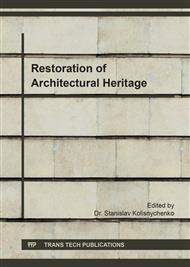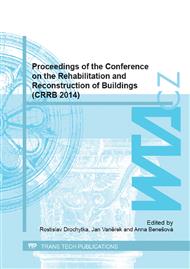p.145
p.149
p.153
p.157
p.161
p.165
p.169
p.173
p.177
Investigating Interior Changes in Historical Building by Computational Modeling and Determination Critical Places for Structural Conservation
Abstract:
Maintenance and restoration of historical buildings are an important contribution to sustainability of cultural heritage. Refurbishment should be adopted to preserve the essential features of the building ́s history and cultural heritage. Reconstruction of internal plaster in historical buildings belongs to important treatment in a landmark area. Plaster of historical buildings is usually characterized by an open porosity, which makes it sensitive to the degradation caused by physical and chemical agents. Alterations and structural faults can lead to invasive interventions which modify permanently the cultural value and the structural behavior of the buildings, in conflict with necessary preservation requirements.Knowledge of the historical building interior microclimate is essential for the definition of suitable reconstruction. Computer simulation plays major role in determining air flow, which can cause negative influence within historic buildings such as high level of moisture, fungus, chemical reactions etc. In order to prevent deterioration of plaster and to retard their decay, protective products – nanofibers – could be applied on the historical surfaces. Using nanofibers should cause minimal modifications to the historic appearance and protect from negative influences.
Info:
Periodical:
Pages:
161-164
Citation:
Online since:
August 2015
Authors:
Price:
Сopyright:
© 2015 Trans Tech Publications Ltd. All Rights Reserved
Share:
Citation:



